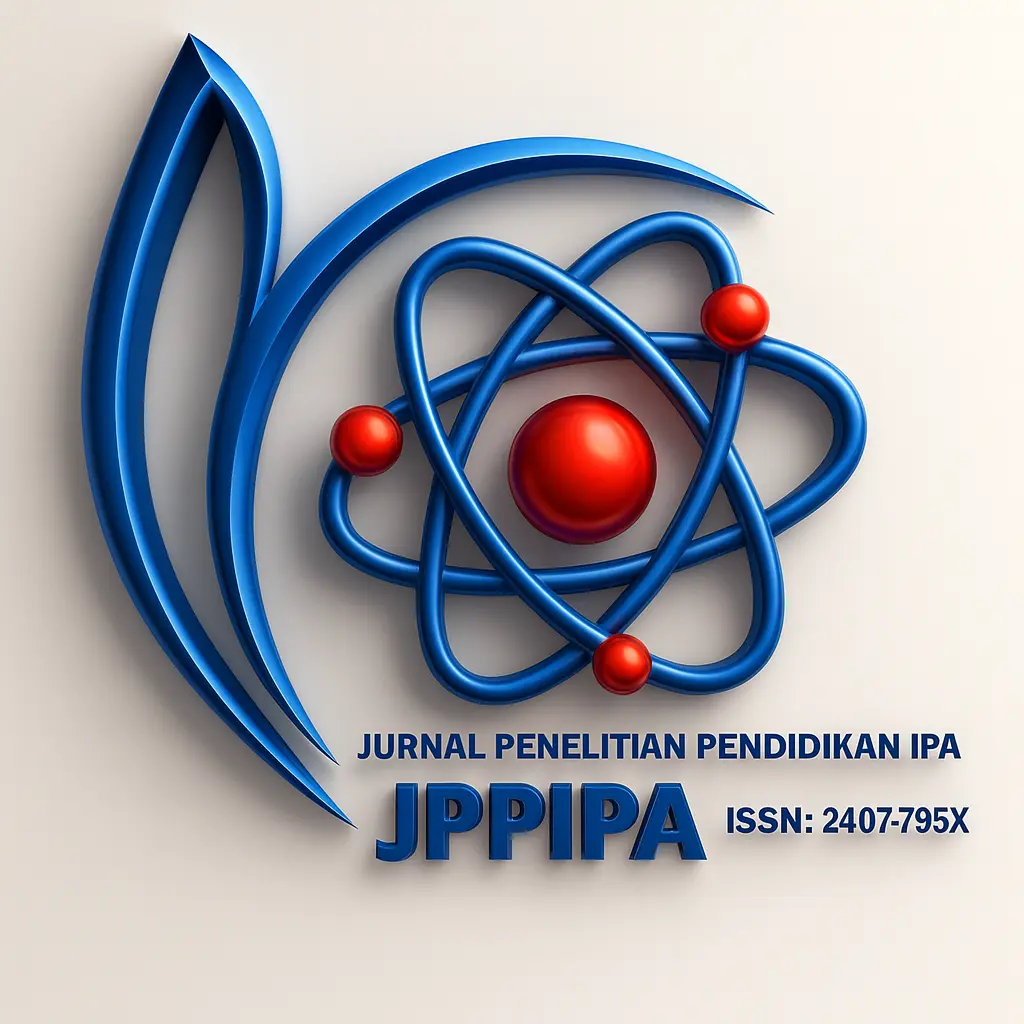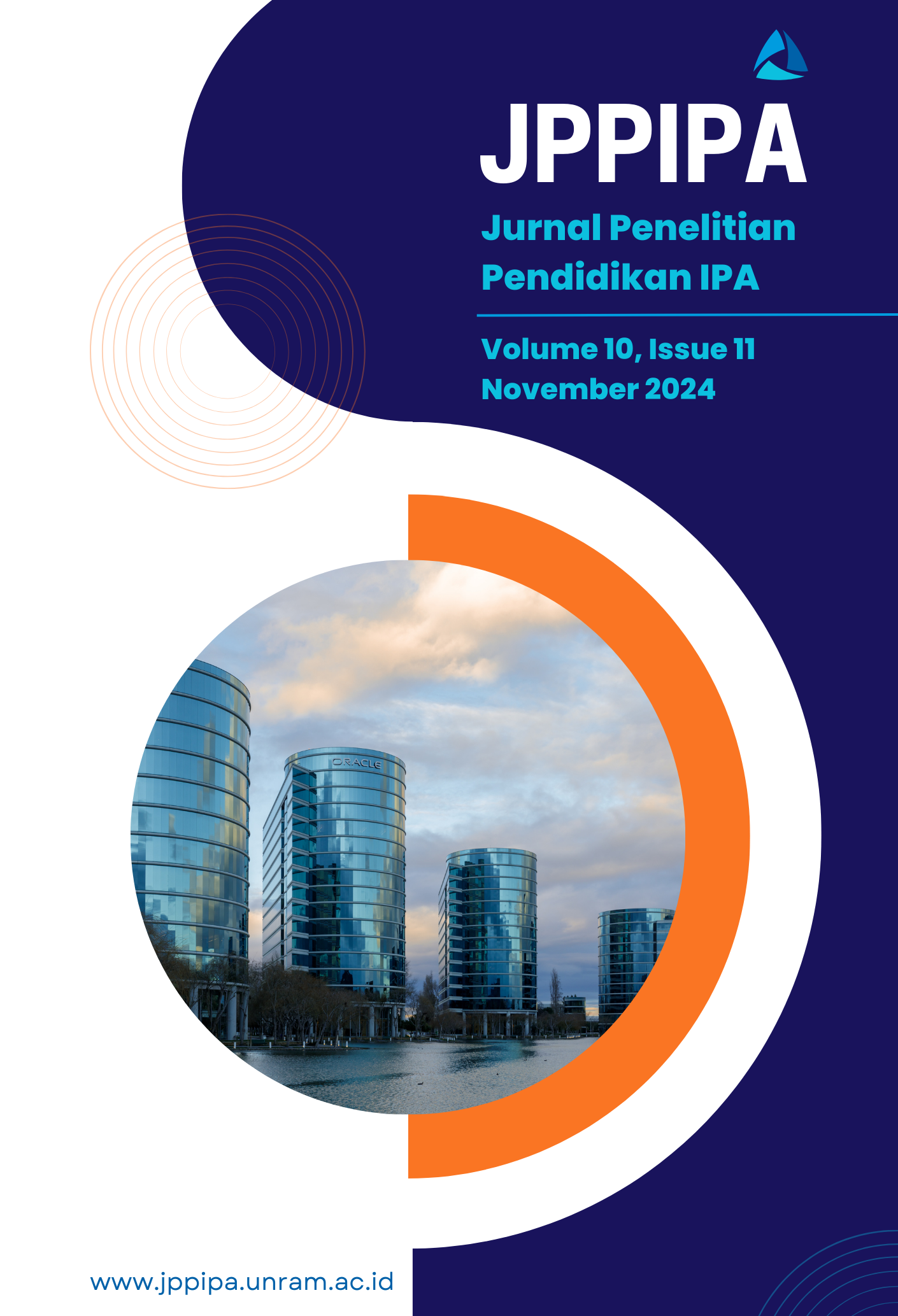Variability of Temperature Extreme Observes in Kalimantan
DOI:
10.29303/jppipa.v10i11.9048Published:
2024-11-25Downloads
Abstract
This study aims to analyze the trend of extreme temperatures in Kalimantan over the past few decades. The data used are daily temperatures from meteorological stations in West Kalimantan, Central Kalimantan, and South Kalimantan, with an observation period of January 1985 to December 2022. The research methodology involves four main stages: data collection, extreme temperature index calculation, trend detection, and correlation analysis with ENSO and IOD. The results showed an increasing trend in extreme temperatures (warming). The increase in mean annual maximum temperature (TXmean) ranged from 0.03°C to 2°C per century, while the mean annual minimum temperature increased from 0.2°C to 0.5°C per century. Monthly maximum value of daily max temperature (TXx) the increasing trend ranged from 0.19°C to 1.7°C, monthly maximum value of daily min temperature (TNx) increased from 0.1°C to 0.5°C. The monthly mean difference between daily max and min temperature (DTR) also shows an increase of 0.5°C to 1.7°C. This trend indicates that daytime (TXmean, TXx) and nighttime (TNmean, TNx) conditions in Kalimantan, especially in West, Central, and South Kalimantan, are getting hotter, with the daytime experiencing a more significant increase in temperature. The correlation between the extreme temperature index and ENSO and IOD is negative and positive, indicating that ENSO and IOD do not fully influence the increase in extreme temperatures. These findings have important implications for disaster mitigation planning and adaptation to climate change in the Kalimantan region.
Keywords:
Climate change, Extreme temperatures, ENSO and IOD, Kalimantan, Mann Kendal testReferences
Agnihotri, I., Punia, M. P., & Sharma, J. R. (2018). Assessment of spatial variations in temperature and precipitation extremes in west-flowing river basin of Kutch, Saurashtra and Marwar, India. Current Science, 114 (2), 322-328. https://doi.org/10.18520/cs/v114/i02/322-328.
Ahima, R. S. (2020). Global warming threatens human thermoregulation and survival. Journal of Clinical Investigation, 130(2), 559–561. https://doi.org/10.1172/JCI135006
Akbar, A. J., & Lubis, A. M. (2022). Analysis of Land and Sea Temperatures Trend During 1985-2021 Period to Understand Local or Global Warming Effect in Bengkulu City. Indonesian Review of Physics, 5(1), 16–24. https://doi.org/10.12928/irip.v5i1.6073
Akhsan, H., Irfan, M., & Iskandar, I. (2023). El Niño Southern Oscillation (ENSO), Indian Ocean Dipole (IOD), and the Rise of Extreme Temperatures in Eastern Sumatra: Exploring Climate Change Dynamics. Jurnal Penelitian Pendidikan IPA, 9(2), 600–608. https://doi.org/10.29303/jppipa.v9i2.3084
Akhsan, H., Romadoni, M., & Ariska, M. (2022). Prediction of Extreme Temperature in South Sumatra and Its Applications at The End of The 21st Century. Jurnal Penelitian Pendidikan IPA, 8(2), 925–931. https://doi.org/10.29303/jppipa.v8i2.1363
Aldrian, E., & Susanto, R. D. (2003). Identification of three dominant rainfall regions within Indonesia and their relationship to sea surface temperature. International Journal of Climatology, 23(12), 1435–1452. https://doi.org/10.1002/joc.950.
Cordero, R. R., Feron, S., Damiani, A., Carrasco, J., Karas, C., Wang, C., Kraamwinkel, C. T., & Beaulieu, A. (2024). Extreme fire weather in Chile driven by climate change and El Niño–Southern Oscillation (ENSO). Scientific Reports, 14, 1974. https://doi.org/10.1038/s41598-024-52481-x 2.
Ebi, K. L., Capon, A., Berry, P., Broderick, C., de Dear, R., Havenith, G., Honda, Y., Kovats, R. S., Ma, W., Malik, A., Morris, N. B., Nybo, L., Seneviratne, S. I., Vanos, J., & Jay, O. (2021). Hot weather and heat extremes: health risks. The Lancet, 398(10301), 698–708. https://doi.org/10.1016/S0140-6736(21)01208-3
Eboy, O. V., & Kemarau, R. A. (2023). Analysis of Extreme Heat Land Surface Temperature at a Tropical City (1988-2022): A Study on the Variability of Hot Spot during El Niño Southern Oscillation (ENSO). Science and Technology Indonesia, 8(3), 388–396. https://doi.org/10.26554/sti.2023.8.3.388-396.
Hooijer, A., Silvius, M., Wösten, H., & Page, S. (2006). PEAT-CO2. Assessment of CO2 emissions from drained peatlands in SE Asia. Retrieved from https://inis.iaea.org/Search/search.aspx?orig_q=RN:42022627
Kemarau, R., A., Eboy, O., V. (2023). Exploring the Impact of El Niño–Southern Oscillation (ENSO) on Temperature Distribution Using Remote Sensing: A Case Study in Kuching City. Applied Sciences, 13, 8861. https://doi.org/10.3390/app13158861.
Kirana, A. P., Sitanggang, I. S., Syaufina, L., & Bhawiyuga, A. (2020). Spatial and Temporal Clustering Analysis of Hotspot Pattern Distribution of Critical Land in Kalimantan, Indonesia. IOP Conference of Series: Earth and Enviromental Science, 528, 012042. https://doi.org/10.1088/1755-1315/528/1/012042.
Kamaliah, K., & Marlina, S. (2021). Kajian Dampak dan Adaptasi Perubahan Iklim di Kalimantan Tengah. Media Ilmiah Teknik Lingkungan, 6(1), 34–42. https://doi.org/10.33084/mitl.v6i1.2105hing.
IPCC. (2023). Climate change 2023: synthesis report. Contribution of working groups I, II and III to the sixth assessment report of the intergovernmental panel on climate change. The Australian National University.
Lohberger, S., Atwood, E. C., & Siegert, F. (2017). Spatial evaluation of Indonesia’s 2015 fire-affected area and estimated carbon emissions using Sentinel-1. Wiley Global Change Biology, 1–11. https://doi.org/10.1111/gcb.13841.
Manaswini, G., & Sudhakar Reddy, C. (2015). Geospatial monitoring and prioritization of forest fire incidences in Andhra Pradesh, India. Environmental Monitoring and Assessment, 187(10). https://doi.org/10.1007/s10661-015-4821-y.
Masud, M. B., Soni, P., Shrestha, S., & Tripathi, N. K. (2016). Changes in Climate Extremes over North Thailand, 1960–2099. Journal of Climatology, 1-18. http://dx.doi.org/10.1155/2016/4289454.
Moura, M. M., dos Santos, A. R., Pezzopane, J. E. M., Alexandre, R. S., da Silva, S. F., Pimentel, S. M., de Andrade, M. S. S., Silva, F. G. R., Branco, E. R. F., Moreira, T. R., da Silva, R. G., & de Carvalho, J. R. (2019). Relation of El Niño and La Niña phenomena to precipitation, evapotranspiration and temperature in the Amazon basin. Science of the Total Environment, 651, 1639–1651. https://doi.org/10.1016/j.scitotenv.2018.09.242.
Nawaz, Z., Li, X., Chen, Y., Guo, Y., Wang, X., & Nawaz, N. (2019). Temporal and Spatial Characteristics of Precipitation and Temperature in Punjab, Pakistan. Water, 11, 1916. https://doi.org/10.3390/w11091916.
Nurdiati, S., Sopaheluwakan, A., Septiawan, P., Ardhana, M. R. (2022). Joint Spatio-Temporal Analysis of Various Wildfire and Drought Indicators in Indonesia. Atmosphere, 13, 1591. https://doi.org/10.3390/ atmos13101591.
Peterson, T., Folland, C., Gruza, G., Hogg, W., Mokssit, A., & Plummer, N. (2001). Report on the activities of the working group on climate change detection and related rapporteurs (p. 143). Geneva: World Meteorological Organization. Retrieved from http://etccdi.pacificclimate.org/docs/wgccd.2001.pdf.
Prinz, D. (2009). Contributor and Victim - Indonesia’s Role in Global Climate Change with Special Reference to Kalimantan. Jurnal Sains &Teknologi Lingkungan, 1(2), 138–153. https://doi.org/10.20885/jstl.vol1.iss2.art5.
Qu, Y., Liu, Y., Jevrejeva, S., & Jackson, L. P. (2020). Future sea level rise along the coast of China and adjacent region under 1.5 °C and 2.0 °C global warming. Advances in Climate Change Research, 11 (3), 227–238. https://doi.org/10.1016/j.accre.2020.09.001
Robertson, A. W., Moron, V., Qian, J. H., Chang, C. P., Tangang, F., Aldrian, E., Koh, T. Y., & Juneng, L. (2011). The Maritime Continent Monsoon. World Scientific Publishing. https://doi.org/10.1142/9789814343411_0006
Sarmiasih, M., & Pratama, P. Y. (2019). The Problematics Mitigation of Forest and Land Fire District Kerhutla) in Policy Perspective (A Case Study : Kalimantan and Sumatra in Period 2015-2019). Journal of Governance and Public Policy, 6(3). https://doi.org/10.18196/jgpp.63113.
Sa'adi, Z., Yaseen, Z. M., Farooque, A. A., Mohamad, N. A., Muhammad, M. K. I., & Iqbal, Z. (2023). Long-term trend analysis of extreme climate in Sarawak tropical peatland under the influence of climate change. Weather and Climate Extremes, 40, 100554. https://doi.org/10.1016/j.wace.2023.100554.
Safitri, R., Marzuki, Shafii, M. A., Yusnaini, H., & Ramadhan. (2022). Effects of Land Cover Change and Deforestation on Rainfall and Surface Temperature in New Capital City of Indonesia. Jurnal Penelitian Pendidikan IPA, 8(6), 2849–2858. https://doi.org/10.29303/jppipa.v8i6.2182.
Sen, P. K. (2013). Estimates of the Regression Coefficient Based on Kendal’s Tau. Journal of Chemical Information and Modeling, 53(9), 1689–1699. Retrieved from http://www.jstor.org/stable/2285891
Siswanto, S., van Oldenborgh, G. J., van der Schrier, G., Jilderda, R., & van den Hurk, B. (2016). Temperature, extreme precipitation, and diurnal rainfall changes in the urbanized Jakarta city during the past 130 years. International Journal of Climatology, 36(9), 3207–3225. https://doi.org/10.1002/joc.4548
Supari, Tangang, F., Juneng, L., & Aldrian, E. (2016a). Observed changes in extreme temperature and precipitation over Indonesia. International Journal of Climatology, 37(4), 1979–1997. https://doi.org/10.1002/joc.4829
Supari, Tangang, F., Juneng, L., & Aldrian, E. (2016b). Spatio-temporal Characteristics of Temperature and Precipitation Extremes in Indonesian Borneo. AIP Conference Proceedings, 1784, 060050. https://doi.org/10.1063/1.4966888
Supari, Tangang, F., Salimun, E., Aldrian, E., Sopaheluwakan, A., & Juneng, L. (2017). ENSO modulation of seasonal rainfall and extremes in Indonesia. Climate Dynamics. https://doi.org/10.1007/s00382-017-4028-8
Tan, M. L., Juneng, L., Tangang, F. T., Chung, J. X., & Radin Firdaus, R. B. (2021). Changes in temperature extremes and their relationship with ENSO in Malaysia from 1985 to 2018. International Journal of Climatology, 41(S1), E2564–E2580. https://doi.org/10.1002/joc.6864
Thirumalai, K., DInezio, P. N., Okumura, Y., & Deser, C. (2017). Extreme temperatures in Southeast Asia caused by El Ninõ and worsened by global warming. Nature Communications, 8, 1–8. https://doi.org/10.1038/ncomms15531
Wooster, M. J., Perry, G. L. W., & Zoumas, A. (2012). Fire, drought and El Niño relationships on Borneo (Southeast Asia) in the pre-MODIS era (1980-2000). Biogeosciences, 9(1), 317–340. https://doi.org/10.5194/bg-9-317-2012
World Research Institute. 10 Big Findings from the 2023 IPCC Report on Climate Change. Retrieved from https://www.wri.org/insights/2023-ipcc-ar6-synthesis-report-climate-change-findings.
Yang, S., Li, Z., Yu, J. Y., Hu, X., Dong, W., & He, S. (2018). El Niño-Southern Oscillation and its impact in the changing climate. National Science Review, 5(6), 840–857. https://doi.org/10.1093/nsr/nwy046
Yulianti, N., & Hayasaka, H. (2013). Recent Active Fires under El Nino Conditions in Kalimantan, Indonesia. American Journal of Plant Sciences, 04(03), 685–696. https://doi.org/10.4236/ajps.2013.43a087
Zhang, X., Alexander, L., Hegerl, G. C., Jones, P., Tank, A. K., Peterson, T. C., Trewin, B., & Zwiers, F. W. (2011). Indices for monitoring changes in extremes based on daily temperature and precipitation data. Wiley Interdisciplinary Reviews: Climate Change, 2(6), 851–870. https://doi.org/10.1002/wcc.147
License
Copyright (c) 2024 Jamiatul Khairunnisa Putri, Suhadi, Muhammad Irfan, Hamdi Akhsan, Iskhaq Iskandar

This work is licensed under a Creative Commons Attribution 4.0 International License.
Authors who publish with Jurnal Penelitian Pendidikan IPA, agree to the following terms:
- Authors retain copyright and grant the journal right of first publication with the work simultaneously licensed under a Creative Commons Attribution 4.0 International License (CC-BY License). This license allows authors to use all articles, data sets, graphics, and appendices in data mining applications, search engines, web sites, blogs, and other platforms by providing an appropriate reference. The journal allows the author(s) to hold the copyright without restrictions and will retain publishing rights without restrictions.
- Authors are able to enter into separate, additional contractual arrangements for the non-exclusive distribution of the journal's published version of the work (e.g., post it to an institutional repository or publish it in a book), with an acknowledgment of its initial publication in Jurnal Penelitian Pendidikan IPA.
- Authors are permitted and encouraged to post their work online (e.g., in institutional repositories or on their website) prior to and during the submission process, as it can lead to productive exchanges, as well as earlier and greater citation of published work (See The Effect of Open Access).









